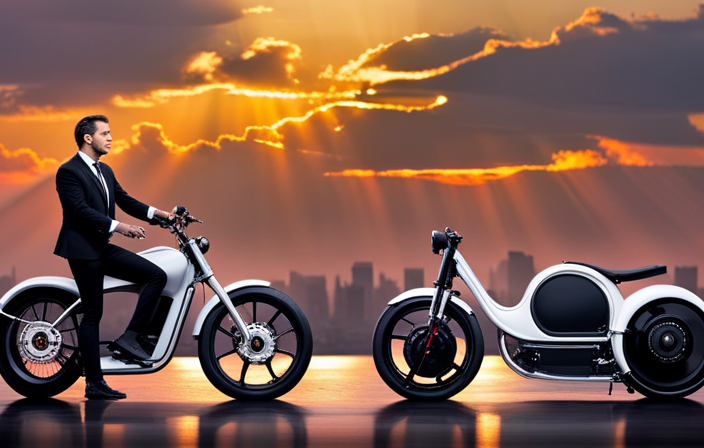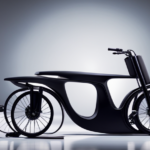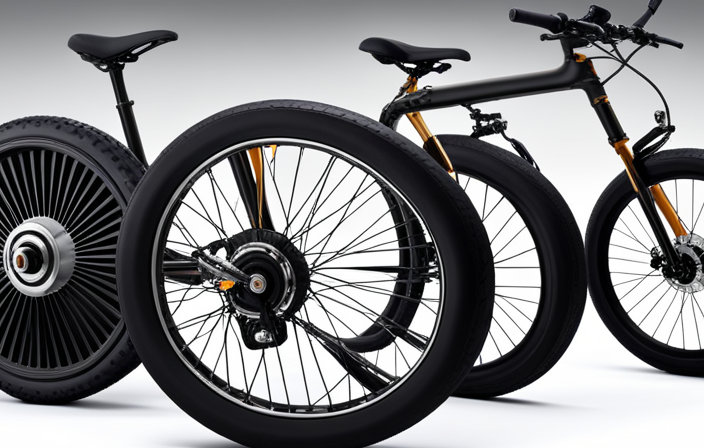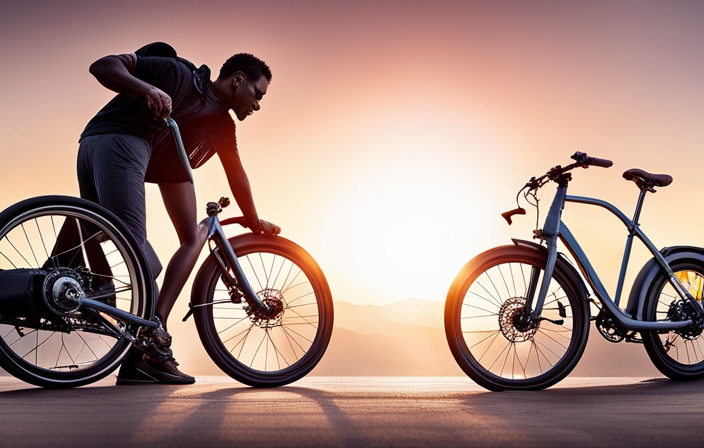Imagine zipping through the city streets or exploring scenic trails with ease. Curious about the differences between an electric bike and a hybrid bike? Look no further!
In this article, we’ll break it down for you. You’ll discover the power sources, speed and range capabilities, ease of use, fitness benefits, costs, maintenance, and environmental impact of these two popular bike options.
By the end, you’ll have all the information you need to choose the perfect bike for your needs. Let’s dive in!
Key Takeaways
- Electric bikes provide adjustable assistance levels and engage leg muscles, while hybrid bikes require more effort and engage in physical activity outdoors.
- Electric bikes have complex electrical systems that require regular maintenance and expensive specialized repairs and parts, while hybrid bikes have a simpler design and are easier to maintain and repair.
- Electric bikes have a higher cost compared to hybrid bikes, while hybrid bikes have a lower cost.
- Electric bikes have zero emissions while riding and are more environmentally friendly compared to traditional bikes, while hybrid bikes require more energy to operate and are less environmentally friendly compared to electric bikes.
Electric Bike Basics
An electric bike is a bicycle that is powered by an electric motor, allowing you to pedal or use the motor to assist in your journey. These bikes are a fantastic option for riders who want an extra boost of power while cycling.
The electric motor is typically located in the hub of the rear wheel or in the center of the bike frame. It provides assistance when you pedal, making it easier to climb hills or ride against strong winds.
Electric bikes usually have a range of around 20-50 miles per charge, depending on the battery capacity and terrain.
Now that you understand the basics of electric bikes, let’s move on to the next section about hybrid bike basics.
Hybrid Bike Basics
If you’re looking for a versatile and practical bike that can handle a variety of terrains, a hybrid bike might be the perfect choice for you. These bikes are designed with features that combine the best of both road and mountain bikes, making them suitable for both urban commuting and off-road adventures.
One of the key features of a hybrid bike is its lightweight frame, which allows for easy maneuverability and efficient pedaling. Additionally, hybrid bikes often come equipped with wider tires and a comfortable upright riding position, providing stability and comfort during long rides.
Riding a hybrid bike offers several advantages, such as the ability to navigate through city streets with ease while also being able to tackle more rugged trails. The versatility of a hybrid bike makes it a great option for riders who want a bike that can handle various types of terrain and riding conditions.
Features of a Hybrid Bike
You can easily identify a hybrid bike by its combination of both road bike and mountain bike features. Here are some key features that make hybrid bikes stand out:
-
Versatility: Hybrid bikes are designed to handle a variety of terrains, making them perfect for commuting, leisurely rides, and light off-road adventures.
-
Comfortable riding position: With a slightly upright riding position, hybrid bikes offer a more comfortable and ergonomic experience compared to road bikes.
-
Wide tires: Hybrid bikes typically have wider tires than road bikes, providing better stability and grip on different surfaces.
-
Integrated features: Many hybrid bikes come equipped with features like fenders, racks, and lights, making them practical and convenient for daily use.
With these features, hybrid bikes offer a great balance between speed, comfort, and versatility. Now, let’s explore the advantages of riding a hybrid bike.
Advantages of Riding a Hybrid Bike
Hybrid bikes offer a comfortable and versatile riding experience, making them a popular choice for commuters and leisure riders. One of the main advantages of riding a hybrid bike is that it combines the best features of both road bikes and mountain bikes.
With their slightly wider tires and upright riding position, hybrid bikes provide excellent comfort and stability on various surfaces, including paved roads, gravel paths, and light trails. They also typically come equipped with a range of gears, allowing you to easily tackle different terrains and gradients.
Another advantage of hybrid bikes is their ability to accommodate accessories such as racks and fenders, making them practical for carrying groceries or commuting to work.
Transitioning to the next section, let’s now explore the power source of hybrid bikes.
Power Source
The main difference between an electric bike and a hybrid bike is their power source. An electric bike, as the name suggests, is powered by an electric motor and a rechargeable battery. On the other hand, a hybrid bike combines human power with a small electric motor. Let’s compare the two in terms of their power sources:
| Electric Bike | Hybrid Bike |
|---|---|
| Powered by an electric motor and a rechargeable battery. | Combines human power with a small electric motor. |
| Offers a fully motorized experience. | Provides assistance to the rider while pedaling. |
| Can reach higher speeds and cover longer distances without much effort. | Requires more effort from the rider and has a limited range. |
| Ideal for those who want a more relaxed and effortless ride. | Suitable for those who want a bit of assistance during their rides. |
| Requires charging the battery to keep it running. | Does not require charging as it relies on pedaling for power. |
Now that you understand the difference in power sources between electric and hybrid bikes, let’s move on to the next section, where we will discuss their speed and range.
Speed and Range
Powered by an electric motor and a rechargeable battery, an electric bike can reach higher speeds and cover longer distances without much effort. With the assistance of the motor, you can easily pedal at speeds of up to 20-28 mph, which is significantly faster than a traditional bike.
Electric bikes also have a longer range compared to their non-electric counterparts. Depending on the battery capacity, you can travel anywhere from 20 to 80 miles on a single charge. This extended range makes electric bikes a great option for longer commutes or leisurely rides without worrying about running out of power.
Now, let’s move on to the next section and explore the ease of use of electric bikes.
Ease of Use
When using an electric bike, you’ll find that it’s incredibly easy to navigate through traffic and effortlessly climb hills. Here’s why:
-
Smooth acceleration: With the assistance of the electric motor, you can effortlessly start moving from a standstill without exerting much effort. It’s like having a gentle push to get you going.
-
Effortless climbing: Electric bikes are equipped with powerful motors that provide extra power when going uphill. You can conquer steep inclines with ease, without feeling fatigued or out of breath.
-
Maneuverability: Electric bikes are designed to be lightweight and agile, making them easy to handle in tight spaces. You can weave through traffic with confidence, easily avoiding congestion and arriving at your destination faster.
With these features, electric bikes offer a user-friendly riding experience that makes commuting a breeze.
Now let’s delve into the next section about terrain and riding conditions, where we’ll explore how electric bikes perform in different environments.
Terrain and Riding Conditions
With their powerful motors, electric bikes effortlessly conquer steep inclines, making them ideal for hilly terrains and challenging riding conditions. Whether you’re tackling a mountain trail or navigating through a bustling city, an electric bike provides the extra boost you need to handle any terrain.
The electric motor kicks in as soon as you start pedaling, giving you a seamless and effortless riding experience. This means you can focus on enjoying the ride rather than struggling to conquer difficult hills. Electric bikes also come equipped with different modes, allowing you to adjust the level of assistance based on the terrain or your personal preference.
Now, let’s explore how electric bikes can contribute to your fitness and exercise routine.
Fitness and Exercise
Riding an electric bike can provide numerous health benefits for you. Not only does it offer a low-impact form of exercise, but it also allows you to control the level of assistance you need. With an electric bike, you can enjoy the physical activity without feeling too overwhelmed or exhausted.
On the other hand, a hybrid bike offers a more traditional biking experience, providing you with a great opportunity for physical activity and cardiovascular exercise. It allows you to engage your leg muscles and burn calories while enjoying the outdoors.
Health Benefits of Riding an Electric Bike
To improve your cardiovascular health, you can’t go wrong with riding an electric bike. Electric bikes, also known as e-bikes, offer a unique and convenient way to incorporate exercise into your daily routine.
These bikes are equipped with a motor that assists you while pedaling, making it easier to conquer hills and long distances. By riding an electric bike, you engage in a low-impact aerobic exercise that gets your heart pumping and improves blood circulation. Plus, you have the freedom to adjust the level of assistance provided by the motor, allowing you to challenge yourself as you progress.
Riding an electric bike is not only a fun and efficient mode of transportation but also a fantastic way to improve your cardiovascular fitness.
Transitioning into the subsequent section about physical activity with a hybrid bike, it is important to note that hybrid bikes offer a more traditional cycling experience without an electric motor.
Physical Activity with a Hybrid Bike
Now that you’re aware of the health benefits that come with riding an electric bike, let’s explore the physical activity you can enjoy with a hybrid bike.
Unlike an electric bike, a hybrid bike requires you to put in more effort, making it a great option if you’re looking to get a workout while riding. A hybrid bike combines the features of a road bike and a mountain bike, giving you the best of both worlds.
With its lightweight frame and narrower tires, you can easily pedal on paved roads and enjoy a smooth ride. However, if you feel like exploring off-road trails or tackling more challenging terrains, the wider tires and sturdy construction of a hybrid bike allow you to do so with ease.
Whether you’re commuting to work, running errands, or going on leisurely rides, a hybrid bike offers a fantastic way to engage in physical activity while enjoying the outdoors.
As you consider the physical benefits of riding a hybrid bike, it’s also important to think about the cost and maintenance that come with owning one.
Cost and Maintenance
If you’re considering an electric bike or a hybrid bike, you should know that maintenance and cost differ between the two.
Electric bikes require more maintenance than hybrid bikes due to their complex electrical systems. You’ll need to regularly check the battery life, motor performance, and electrical connections. Additionally, electric bikes may require specialized repairs and replacement parts, which can be more expensive compared to traditional bike components.
On the other hand, hybrid bikes have a simpler design and fewer components, making them easier to maintain and repair. The cost of a hybrid bike is generally lower than that of an electric bike, as you don’t have to invest in an expensive battery and motor.
However, it’s important to consider your specific needs and usage patterns when deciding between the two.
Now, let’s move on to the environmental impact of these bikes.
Environmental Impact
When considering the environmental impact, you should take into account factors such as energy consumption and carbon emissions.
Electric bikes, also known as e-bikes, are powered by a rechargeable battery and an electric motor. These bikes produce zero emissions while riding, making them a more environmentally friendly option compared to traditional bikes or even hybrid bikes.
Hybrid bikes, on the other hand, use a combination of human pedaling power and a small electric motor. While they still offer some environmental benefits, they do require more energy to operate compared to e-bikes.
By choosing an electric bike, you can significantly reduce your carbon footprint and contribute to a cleaner and greener environment.
Now, let’s move on to the next section and explore how to choose the right bike for you.
Choosing the Right Bike for You
To determine which bike is right for you, consider factors such as your preferred riding style, terrain, and desired level of assistance.
If you enjoy a leisurely ride on flat roads or paved trails, a hybrid bike might be a good fit. Hybrid bikes are designed for comfort and versatility, with a combination of features from both road and mountain bikes. They are suitable for a variety of terrains and offer a smooth and stable ride.
On the other hand, if you are looking for a bike that provides an extra boost of power, an electric bike might be the better choice. Electric bikes come with a motor that assists with pedaling, allowing you to go faster and climb hills with ease. They are great for commuting or longer rides where you may need some assistance.
Ultimately, the right bike for you depends on your personal preferences and needs.
Conclusion
So there you have it, the difference between an electric bike and a hybrid bike.
While both options offer their own unique advantages, it ultimately comes down to your personal preferences and needs.
Electric bikes provide the convenience of a motorized boost, making your rides effortless and enjoyable.
On the other hand, hybrid bikes offer a more traditional cycling experience, allowing you to get a good workout while still having the option to switch on the electric assist when needed.
Whichever bike you choose, happy riding!
















